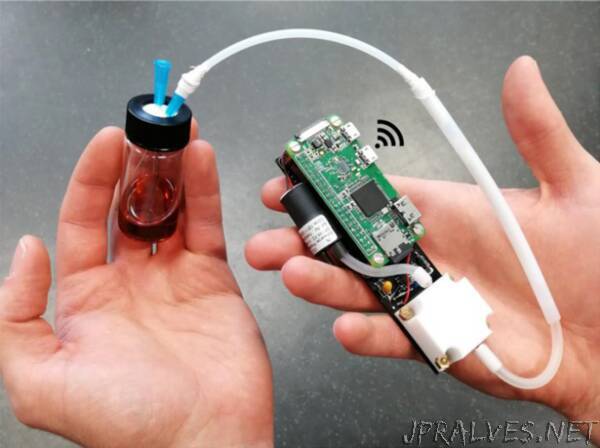
“ETH researchers at the Department of Mechanical and Process Engineering have developed a device that detects low concentrations of methanol in alcoholic beverages. The results are displayed on a smartphone wirelessly in real time.
Methanol can be lethal, even if it only occurs in small amounts. In 2019, at least 789 people who consumed alcoholic beverages contaminated with methanol died – mostly in Asia. The chemical is formed naturally when pectin is broken down during fermentation. However, the drinks are often deliberately adulterated with cheap methanol to increase profit and potency. Methanol becomes highly toxic when metabolized by the human body and at worst can be deadly.
Cheap, portable and easy to use
Until now, chemical methods were necessary to detect methanol. They are expensive, slow and only applicable in the laboratory. Compact gas sensors can be used too, but they only work with a low alcohol content and cannot distinguish methanol from the harmless ethanol. There is a need for inexpensive and reliable detectors that can be carried easily and are simple to operate.
In September 2019, the researchers presented the new technology (see grey box), which “sniffs out” methanol and ethanol vapors within two minutes. Now they have reached another milestone. “The main innovation is that we have turned the initial concept into a fully integrated, handheld detector, which sniffs out the smallest amounts of methanol in beverages from all continents and displays the results on a smartphone wirelessly,” says Dr. Andreas Güntner from Professor Sotiris Pratsinis’ Particle Technology Laboratory at the Institute of Energy and Process Engineering of the Department of Mechanical and Process Engineering. Whether it is wine, whiskey, rum, sake or fruit schnapps from the local traditional distillery Fassbind, the device reliably detects methanol.
The device weighs only 94 grams and measures 2x4x12 centimeters. It is powered by a battery. The results are sent to the smartphone via Wifi and displayed immediately. If no Wifi connection is available, Bluetooth can be used. The app runs on Android and iOS and should also be compatible with older devices.
One device for many purposes
The device can be used by consumers and manufacturers to determine the methanol content of alcoholic beverages. But the application does not end there. The rapid detection of methanol - perhaps even in the breath of intoxicated people - could also be useful for healthcare workers and law-enforcing authorities. The design could also be applied to other food contaminants, for example to detect ammonia in spoiled seafood. As the technology is inexpensive, it is particularly suitable for poorer regions where food safety is a concern.”
